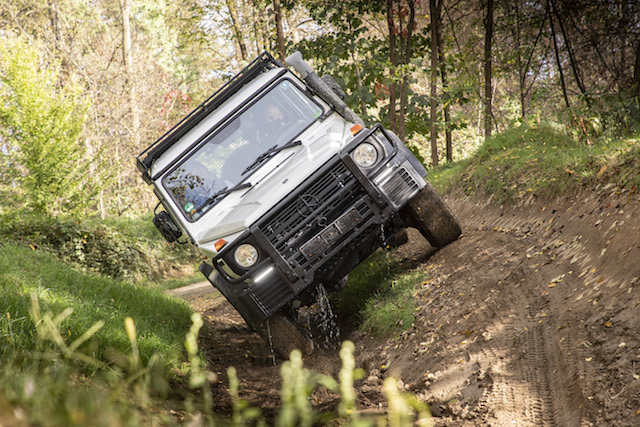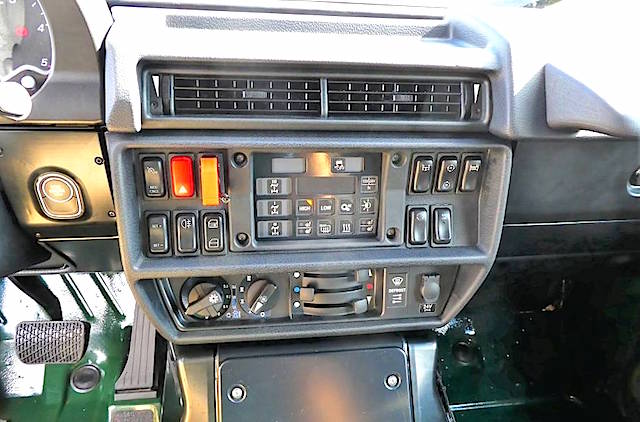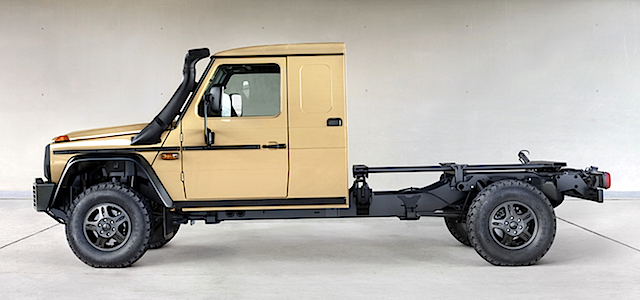
A variant of the Mercedes-Benz G-Wagen that is unlikely to find a role in New Zealand comes with an electronic emergency device designed to hustle the vehicle and its occupants away from life-threatening situations.
It’s called the Emergency Override Switch, a panic button, of sorts. M-B isn’t saying how it works exactly. Nor does it offer an example of life-threatening duress, although a shootout would be a reasonable guess – the G-Wagen’s seats are designed for occupants wearing body armour.
Once activated, EOS allows the engine and other crucial components to work at maximum capacity. It will, for example, bypass overheating protection. The engine will likely be damaged as a result, but lives might have been saved.
EOS is pictured below. It is the orange switch third from the left below the air vents. It is longer than the other switches for one reason – it’s for emergencies only.
Everything about the so-called ‘search and rescue’ G-Wagen W464 350d is made to handle the world’s worst of everything. Its 3.0-litre inline-six diesel engine has been modified to run on the dirtiest diesel, of a type found in many poor countries, or far-flung outposts.
It can consistently run on diesel with 500 parts-per-million (ppm) of corrosive sulphur, says M-B. That’s 50 times dirtier than the New Zealand standard. It can even, says an independent European analysis, run for 400 hours on diesel with 3000ppm of sulphur, a sort of stinky fuel oil.
G-Wagen W464 350d Spec is available in two configurations: a five-door, four-seat wagon (BR06) with a 2850mm wheelbase, or a two-door cab chassis (BR09) with a 3650mm wheelbase.
The wagon has a one-tonne payload (200kg of which can be carried on the roof), and space between and behind the two rear seats for rescue gear and such. The cab-chassis has a whopping 2.5-tonne payload.
Both have a maximum braked towing capacity of 3.5 tonne and both come with a choice of 80- or 96-litre fuel tanks and a 24-volt electrical system.
Other highlights:
- LED exterior lighting technology
- Splashproof and glove-friendly interior (no fiddly switches)
- Upgraded cooling system
- Updated seats and steering wheel
- Crawl speed between 2 and 14 km/h
- Running temperatures between -35° and 50°C
- Ground clearance of 221mm
- Wading depth of 660mm
- Maximum operating altitude of 4000m (higher than NZ’s Mt Cook)
W464 350d shares its utilitarian DNA with the first-generation model, known as the W461. M-B has sold more than 60,000 W461 variants worldwide since it was launched in 1979. W461 has a narrower body and track and ‘classic’ chassis, with solid live axles front and rear.
It’s a hugely different beast from the 2018 second-generation W463 G-Wagen, the luxurious civvy-street model on sale in New Zealand with either 4.0-litre V8 petrol (AMG G63) or 3.0-litre inline-six (G400d) diesel power. The W463 has an independent front suspension set-up and a wider track.
The 3.0-litre diesels used by the W464 350d and the G400d are one and the same, but different. The 350d unit is Euro3 (a 2001 emissions standard) and the G400d is Euro6 (current standard introduced in 2015). The detuned 350d generates 183kW/600Nm; the G400d is good for 243kW/700Nm.
Both models run a nine-speed automatic transmission which sends drive to all four wheels. Both have front, centre, and rear locking differentials for use when the electronic traction control isn’t enough.
But the W464 350d’s transmission is specially calibrated to deliver a crawl speed between 2km/h and 14km/h in the lowest ratios, or when one or all of the three differentials is locked.



